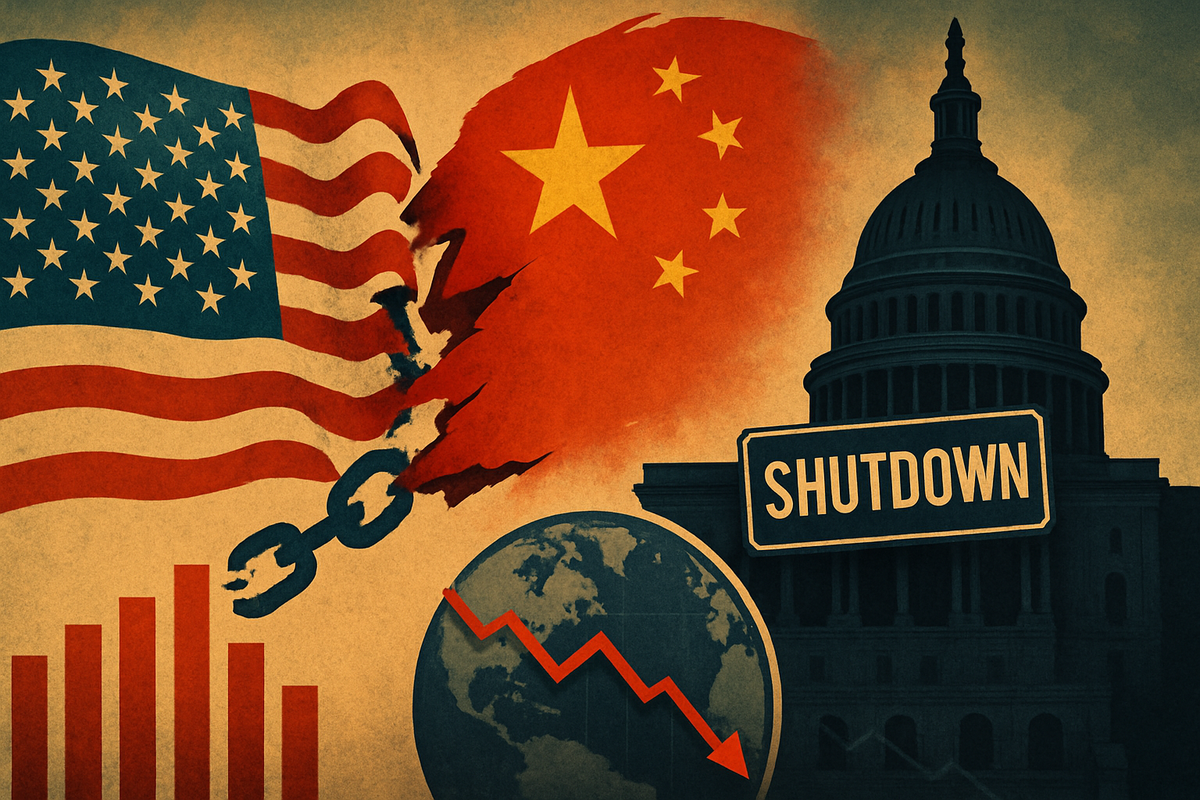
The global financial landscape is currently navigating a treacherous confluence of escalating US-China trade tensions and a protracted US government shutdown, casting a long shadow over market sentiment and economic stability. As of October 2025, the world's two largest economies are engaged in an accelerating economic decoupling, marked by new tariffs and retaliatory measures, while domestic political paralysis in the United States threatens essential government services and economic data flows. This dual crisis is creating unprecedented uncertainty, pushing global markets into a state of heightened volatility and prompting fears of a significant economic downturn.
The immediate implications are far-reaching: supply chains are being re-evaluated, corporate profitability faces significant headwinds, and consumer confidence is eroding. Analysts are warning of a potential global recession if these disputes and political impasses are not resolved swiftly, with the ripple effects threatening to undermine years of economic integration and growth.
A Perfect Storm: Tariffs, Export Controls, and Congressional Stalemate
The current state of affairs is the culmination of several aggressive actions and a persistent political deadlock. On October 10, 2025, President Donald Trump announced plans to impose a staggering additional 100% tariff on Chinese imports, set to take effect on November 1. These new duties, layered atop existing tariffs, could push effective rates as high as 130% or even 145% in certain sectors, effectively pricing many Chinese goods out of the US market. The US also introduced new export controls targeting "any and all critical software," a move designed to restrict China's technological advancement.
China swiftly retaliated. On October 9, its Ministry of Commerce expanded export controls on rare earth elements and related technologies, critical for semiconductors, electric vehicles, and defense systems. These controls are being phased in, with some taking effect immediately, others on November 8, and further restrictions on December 1, 2025. Additionally, China initiated an antitrust investigation into US chipmaker Qualcomm (NASDAQ: QCOM) and, from October 14, imposed new special port service fees on US-owned, operated, and built vessels, mirroring US charges on Chinese ships. These actions follow a year where average US tariffs on Chinese goods had already surged, and bilateral trade has plummeted by an estimated 14.4% in the first eight months of 2025 compared to the previous year.
Domestically, the US federal government entered a shutdown on October 1, 2025, after Congress failed to pass appropriations for fiscal year 2026. Now in its third week, the shutdown stems from a bitter stalemate between Democrats and Republicans over federal spending levels, foreign aid rescissions, and health insurance subsidies. Approximately 900,000 federal employees have been furloughed, and another 700,000 are working without pay, disrupting critical services from national parks to FDA inspections and airport operations. The US Treasury Department estimates economic losses as high as $15 billion per week, with each week reducing annualized GDP growth by about 0.1 percentage point. Global financial markets reacted sharply to these developments, with over $1.5 trillion erased in value within two days of the rare earth announcement and tariff threats. Gold prices surged to an unprecedented all-time high, while oil prices fell due to fears of prolonged tensions and reduced global demand.
Corporate Fortunes in the Crosshairs: Winners and Losers
The escalating trade war and government shutdown are creating a stark divide among public companies, with clear winners and losers emerging from the chaos. Companies heavily reliant on Chinese manufacturing and supply chains are facing severe disruptions and increased costs. Technology giants like Nvidia (NASDAQ: NVDA), Intel (NASDAQ: INTC), and Apple (NASDAQ: AAPL), along with major semiconductor foundries such as TSMC (NYSE: TSM), are particularly vulnerable to China's rare earth export controls and US restrictions on critical software. Their production capabilities, product development, and profitability could be significantly hampered, forcing expensive and time-consuming efforts to diversify supply chains away from China. Qualcomm (NASDAQ: QCOM) faces the additional burden of an antitrust investigation in China, which could lead to substantial fines and restrictions on its market access.
On the other hand, companies with diversified supply chains or those able to "reshore" manufacturing to the US or allied nations may find themselves in a more resilient position. Domestic manufacturers, particularly in sectors where tariffs make Chinese imports less competitive, could see increased demand. Furthermore, the push for rare earth independence might spur investment in mining and processing companies outside of China, creating opportunities for alternative suppliers. However, the overall impact on most companies is negative, as increased costs, reduced global trade, and economic uncertainty weigh heavily.
The government shutdown also inflicts significant pain. Federal contractors, who typically do not receive back pay, are experiencing a halt in projects and cash flow issues. Industries reliant on government permits, inspections, or regulatory approvals, such as pharmaceuticals (regulated by the FDA) or aerospace and defense, face operational delays and uncertainty. The travel industry is also feeling the pinch, with airport staffing shortages leading to delays and reduced public confidence. While no clear "winners" emerge from a government shutdown, companies with robust balance sheets and less direct reliance on federal contracts or immediate regulatory approvals are better positioned to weather the storm, though the broader economic slowdown will eventually affect all.
Broader Implications: Decoupling, Geopolitics, and Fiscal Strain
These twin crises are not isolated incidents but rather critical components of broader, accelerating global trends. The US-China trade dispute is widely seen as a definitive step towards "economic decoupling," reshaping globalization as nations prioritize national security and supply chain resilience over pure economic efficiency. This shift away from deeply integrated global supply chains has profound implications for international trade, investment patterns, and the future of multilateral institutions like the WTO, which projects a 0.2% contraction in global trade for 2025, reversing previous growth.
The ripple effects extend across industries and geographies. J.P. Morgan has downgraded its forecast for global GDP growth to 2.2% for 2025, with China's growth potentially dipping to 4% due to tariff-driven slowdowns. Oxford Economics warns that a full-scale trade war could unleash an economic shock comparable to the onset of COVID-19, potentially slowing US GDP growth by a full percentage point and driving wholesale inflation into double digits. This environment compels competitors and partners worldwide to re-evaluate their own dependencies and strategic alliances, potentially leading to the formation of new trade blocs and increased regionalization of supply chains.
Regulatory and policy implications are also significant. Governments are likely to implement more protectionist measures, subsidies for domestic industries, and stricter export controls. The prolonged US government shutdown highlights deep-seated fiscal policy challenges and political polarization, raising questions about the nation's ability to govern effectively and maintain economic stability. Historically, the current shutdown marks the 21st funding gap and 11th government shutdown in modern US history, and the third during a Trump presidency, underscoring a recurring vulnerability in the US political system that erodes public confidence and impacts global perceptions of American leadership and reliability.
The Path Ahead: Uncertainty and Strategic Adaptation
Looking ahead, the short-term outlook is dominated by continued uncertainty and volatility. The immediate focus will be on the potential meeting between President Trump and Chinese President Xi Jinping at the Asia-Pacific Economic Cooperation (APEC) Summit around October 31 - November 1 in South Korea, which could offer a glimmer of hope for de-escalation, despite President Trump's recent declaration of being "locked in a trade war." Domestically, pressure will mount on Congress to resolve the government shutdown, especially with the approaching end-of-month deadline for military paychecks. Businesses will continue to grapple with supply chain disruptions, increased costs, and the need to find alternative sources for critical components and markets.
In the long term, the economic decoupling between the US and China appears set to accelerate, fundamentally reshaping global trade and investment flows. Companies will need to undertake significant strategic pivots, investing in supply chain diversification, reshoring initiatives, and potentially nearshoring to allied countries. This could create market opportunities for automation technologies, domestic manufacturing, and companies involved in developing alternative rare earth extraction and processing methods. However, challenges will include managing higher production costs, navigating complex new trade regulations, and adapting to a more fragmented global economy. Potential scenarios range from a gradual, managed decoupling to a more abrupt and disruptive "cold economic war," each with distinct implications for market stability and corporate strategy.
Navigating a New Economic Frontier
The current confluence of escalating US-China trade disputes and a prolonged government shutdown presents an unprecedented challenge to the global economy and financial markets. Key takeaways include the accelerating trend of economic decoupling, the significant economic costs of political paralysis, and the heightened volatility now endemic in global markets. Businesses and investors must recognize that the era of seamlessly integrated global supply chains and predictable trade relations is undergoing a profound transformation.
Moving forward, the market will remain highly sensitive to geopolitical developments, particularly any progress or further escalation in US-China trade talks, as well as the resolution of the US government shutdown. Investors should closely monitor corporate earnings reports for insights into how companies are managing supply chain disruptions and increased costs. The outcomes of the APEC summit, ongoing congressional budget negotiations, and inflation data will be crucial indicators. The lasting impact of these events will likely be a more nationalistically focused trade environment, increased emphasis on supply chain resilience, and a sustained period of geopolitical competition that permeates economic policy.
This content is intended for informational purposes only and is not financial advice






